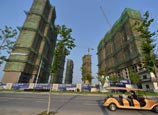
Danjiangkou reservoir, a key player in China's huge water diversion project to quench the thirst of Beijing and about 20 other northern cities, has become a "cesspool" due to rampant discharge of sewage into its tributaries.
The reservoir, located in the border cities of the central provinces of Hubei and Henan, is due to supply water to the northern cities next year, but the China Central Television reported that its waters are not even fit to be used for agricultural irrigation.
Though official data showed that the water was safe enough for drinking, Zhao Zhangyuan, an official from Chinese Research Academy of Environmental Science, said the hydrology bureau declared it fit for drinking because it lacked the indicators for testing. Zhao said, sarcastically, that if the water was good enough for even swimming it should be regarded as good news.
The CCTV report found that reckless dumping in the Hanjiang River, a major water resource for the reservoir, resulted in severe pollution. Hanjiang is the biggest tributary of the Yangtze, China's longest river.
Trash and animal corpses are a common sight in Shending River, an upper reach of Hanjiang, in rural areas in Shiyan City in Hubei Province, despite the government spending hundreds of millions of yuan to clean up the river.
Local farmers blamed the government for "squandering away the national assets" for a "facelift" because only the residues in the downtown section of the river were cleared, CCTV reported.
A smell of strong odor fills the air along the river, which is thick with black mud. Villagers said the water was too dirty even to irrigate the crops and their feet would itch for days if they got into the river.
Worse, the government-funded Shiyan Waste Water Processing Factory, the biggest in the city, diverted sewage, which is intended for the plant to treat, direct into the river, villagers said.
They said the plant built two drainage pipes underground and illegally dumped the unprocessed water directly into the river nearly two or three times a week.
Officials from the plant refused to meet the reporters or comment on the villagers' allegations. The city's environmental protection bureau told CCTV that they had already reported to the city government.
When asked why the illegal discharge was still continuing, an irritated bureau official blamed the plant's "inadequate capacity to process the waste water."
However, the plant, built in 1998 at 276 million yuan and renovated in 2009 at 140 million yuan, is designed to process 60 million tons of waste water per year, while it actually just needs to process 52 million tons per year, CCTV claimed.
The water quality of Shending River and three other tributaries to Hanjiang were tested and ranked as "useless waste water" by a state agency in charge of the Yangtze water resources.
The situation in the upper reaches of Hanjiang in Ziyang County in Shaanxi Province was no better. Residents, restaurants and public toilets along the river discharge waste and faeces into it every day. They said they had no other option because the county's first waste water processing factory was still under construction.
Sewage from the city's biggest drainage outlet empties direct into the river because the sediments pit is too old to serve any purpose.
Therefore, a sea of waste produced by a city of 300,000 people flows into the Danjiangkou Reservoir via Hanjiang, they said. Local citizens dubbed Hanjiang as a natural cesspool of Ziyang, CCTV reported.
China's south-to-north water diversion project, the largest of its kind ever undertaken, consists of three routes - the eastern, middle and western. The Danjiangkou Reservoir is expected to be operational next year.
The project was first conceived by late Chinese leader Mao Zedong in 1952. But China's Cabinet only approved the project in December 2002.
















 Controversial audition for 'rich blind date' -- being pretty is just not enough
Controversial audition for 'rich blind date' -- being pretty is just not enough


![]()
